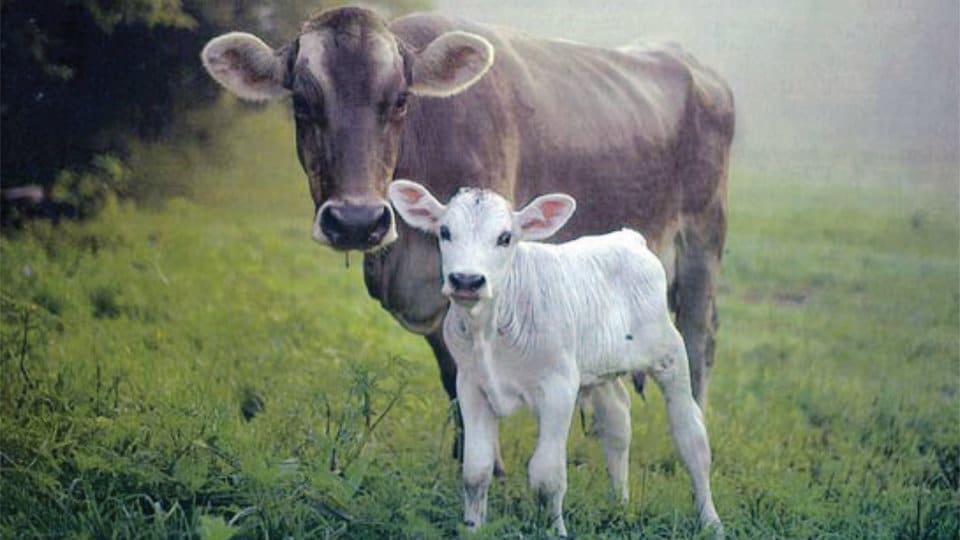By Maneka Gandhi
In this week’s Pet Talk, Maneka speaks about diet for calves’
How does one recognise pure ghee?
To check the purity of ghee at home:
Method 1: Put a spoon of ghee on your palm, if it starts to melt that is pure. Normally, pure ghee melts at the body temperature.
Method 2: Put a spoon of ghee and heat it. If it melts quickly and appears dark brownish in colour, it is pure ghee. Within a few seconds, the ghee will be melted. If it takes a longer time to melt and appears light yellow in colour, it is impure.
Why do dogs like to stick their head out of the car window?
A number of dog behaviourists agree that the window’s main draw isn’t the scenery or the breeze. What dogs are after are smells.
Dogs are basically walking noses. While our human olfactory membranes (a lump of tissue tucked up in the nose) are only about the size of a postage stamp and hold some 5 million olfactory receptors, or “scent cells,” a large dog has an olfactory membrane closer in size to a handkerchief with more than 225 million receptors.
As air moves over the olfactory membrane, odour molecules settle on the scent receptors and get recognised. The more air there is, flowing over the membrane, the more scents the dogs can detect. So when a dog sticks its head out the window, it’s like pigging out at an all-you-can-smell scent buffet.
What is the first thing I should do when I suspect a mange infection?
Take the dog to a vet and get a diagnosis of which mite it is. Diagnoses of the sarcoptic mite means a blood test as well, but this is only effective if the dog has been infected for more than two weeks. iDemodex mites will need to be identified with skin scrapes. Do not start any treatment without this examination.
Are dogs prone to depression?
Yes, dogs are prone to depression and these are the indications that one should look out for. Dog depression symptoms are very similar to those in people:
a) Dogs will become withdrawn and inactive. b) They don’t participate in the things they once enjoyed. c) Their eating and sleeping habits often change.
But, vets warn that these symptoms can also mean a dog has a medical problem. So the first course of action should always be a full check-up by a veterinarian.
What can be fed to calves?
If the calf has a mother, it is important that it be allowed to drink Colostrum, which is the first milk that a mother produces. Colostrum provides passive immunity to disease and helps build up vitamin and mineral levels. The new-born calf should get colostrum within the first 36 hours of birth — either from a mother or from artificial sources. A supply of frozen colostrum can be kept in the freezer, while some milk replacers also contain colostrum. Once the calf has received colostrum, it can be fed solely on whole milk or milk replacers. It is handy to have a bottle of colostrum in the freezer to feed newborn calves that may not have drunk from their mothers. Warm it up to 36°C before feeding, and if you have ample supply, feed it for the first two days (normally up to 2 litres per feed), in the morning and evening.
If the calf is dehydrated, it should be rehydrated before getting any milk. Feeding a dehydrated calf with milk often results in diarrhoea (scours) and possibly death. Electrolyte mixtures are commercially available, or can be mixed at home from 1 teaspoon table salt, ½ teaspoon baking soda and 125 ml glucose in 1.2 L of water. Electrolyte should be fed for at least 24 hours before milk is given.
Cattle are ruminants and have four stomachs. At birth, the abomasum, or fourth stomach, is the only stomach that is functioning. Feeding using teats may be harder work. However, when a calf sucks, it triggers a reflex which causes a groove in the rumen — the oesophageal groove — to close and direct milk past the rumen and into the abomasum where it is digested. Using a teat may also stimulate saliva production and maintain fluid intake in scouring calves. Teats have to be kept clean, and replaced when they deteriorate.
In contrast, if a calf drinks from a bucket, the reflex is often not activated and the milk goes into the rumen. As the rumen is not functioning, the milk is not digested and ferments, causing the calf to scour. If a bucket is used, its base should be placed at least 30 cm above the ground to help the oesophageal groove to close. To train a calf to drink from a bucket, back it into a corner, stand astride its neck and place two fingers, moistened with milk, into its mouth. Whichever method is used, each calf must receive a measured amount of milk daily.
As the calf grows and starts to graze, the other stomachs (rumen, reticulum and omasum) start to develop. Therefore, it is important to provide clean, good quality hay for the calf to eat to help stimulate rumen development. Scouring can quickly lead to death. A scouring calf should be taken off milk for at least four hours and fed electrolytes. If scours continue, treatment with commercial medication may be warranted, in consultation with a vet. Scour medication should be kept on hand, as early treatment can mean the difference between cure and the loss of the calf. Isolate sick calves. Practicing good hygiene, and discarding teats as they deteriorate, will help control sickness in hand-reared calves.
A fresh supply of cool, clean, water should be available at all times and will help keep calves healthy. Calves will begin to drink water between one and two weeks of age and, by six weeks, may drink four to five litres a day. Calves need to have contact with other animals whose rumen is developed to allow them to ‘pick up’ microbes that digest the food in the rumen. These microbes are thought to pass from one animal to another by licking and grazing common ground.
Milk replacers should contain at least 20% protein and 10% fat and no more than 10% starch and sugars (sucrose). Milk replacers should be reconstituted and fed as directed by the manufacturers.
Milk should be given in separate feeds in the morning and evening, preferably at a regular time. As the calf gets older, one feed per day is acceptable — preferably in the morning with access to plenty of cool, clean water thereafter. It is essential to practice good hygiene at all times whilst rearing calves. Do not over-feed calves, especially during their first three weeks of life, as it may cause scouring. As a guide, milk should be fed at 10% of the calf’s body weight per day. Thus, a 30 kg calf should be fed at least 3 L of whole milk per day.
Start baby and weak calves on 250 mL of milk, five times a day for the first 24-48 hours and work up to 2 L twice a day. The best milk temperature is between 35° and 38°C, but it may be fed as cold as 6°C.
Calves may be weaned successfully at a young age; however, providing some milk up to 12 weeks often gives the calf the best opportunity to grow. If the calf has been offered solids from one week of age, it might be weaned off milk after five weeks of age. Weaning should be based on concentrate consumption of at least 650 g of meal a day — not on age. Weaning can be abrupt or by reducing milk over a one-week period.
The weaned calf will require intensive management. Poor management and poor nutrition at this early age may result in a stunted calf that will never recover. Young calves need a diet of 18-20% crude protein with high energy levels of about 11-12 MJ (megajoule).
The calf should have access to hay and concentrates from one week. Avoid giving excessive green grass in the first 6–8 weeks of age to prevent any digestive upsets. By three weeks of age, a calf should be able to digest small amounts of grain meals, hay and, where possible, be given access to young green pasture. Feed changes should be introduced slowly. Depending on the quality of the pasture, supplementary hay and concentrates may be needed until the calf is at least 120 kg live weight.
Calf concentrates should be highly palatable, coarse-textured, high in energy (12 MJ ME/kg or better) and protein (over 16%) and low in roughage (less than 15%). A simple home-mix could consist of four parts cracked or crushed grain (oats, barley, maize or wheat) and one part linseed, soybean, peanut, copra or cottonseed meal. A small amount of molasses may be added to make the mix more palatable. Non-protein nitrogen sources such as urea are not suitable for young calves.
Good grassy lucerne hay is best for young calves — prime lucerne may cause scouring. It should free of mould and weeds. If pasture is scarce, or of poor quality, supplement it with good quality hay.








Our dog vomits after taking food.
What we should do?
Look for your reply